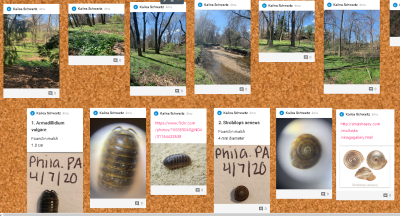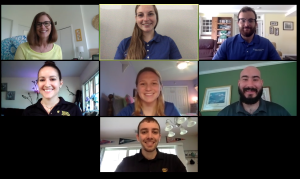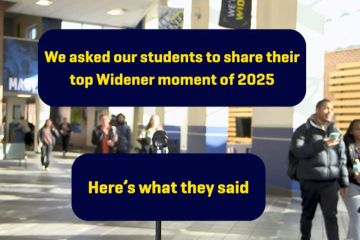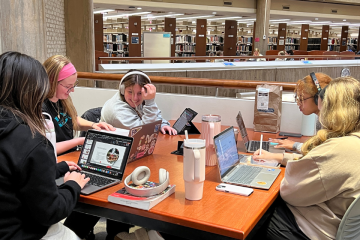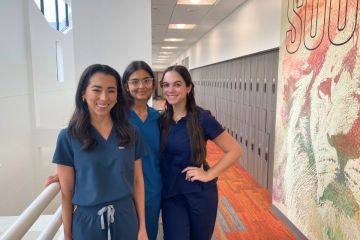Whether Online, In Person, or Both, Widener Always Prioritizes Student Success

When Biology Professor Bruce Grant’s biodiversity spring course shifted online due to COVID-19, the students could no longer collect bugs near campus or examine them in the Kirkbride Hall laboratory. While unexpected, the change in their class circumstances – and location – did not impede progress.
Instead, Grant and his students reimagined their learning environment. From their homes, and in quarantine, the class shifted to a backyard ecology model, in which students collected and compared arthropods from their own cityscapes and suburban yards.
Grant sent each student a micro lens that connected to a cell phone for better viewing and photographing of their samples. The students then uploaded the photos to their journals on a digital bulletin board tool, called Padlet.
By the semester’s end, the class had a data set that spanned the tristate region and virtually presented their “bringing ecology home” project at the campus-wide Student Projects Day.
“This class moved online very smoothly,” said Kailea Schwartz, a biology major and biochemistry minor who graduated in May. “I really enjoyed exploring my area, especially during a time when we were stuck in our houses.”
Grant has continued to use this model in an ecology course this summer. By day, students are discovering plant biodiversity in their yards, and by night, they are using UV-LED lights shined on white sheets to identify moths and other nocturnal invertebrates. Their individual findings contributed to a course project on moth biodiversity from Chester to New York City.
“These experiences, in their own backyards, improve their science education in ways that any discipline in the sciences aspires to do,” Grant said. “They are observing nature and thinking about ecological systems and phenomenon.”
Examples like this show how Widener’s dedicated, innovative faculty have never been held back by conventional education models. They’ve always prioritized student success, whether providing instruction online, in person, or a hybrid of both.
As Widener continues to navigate these unprecedented times, the university is building on the success of the spring semester and preparing for a productive fall. The university has taken a multi-prong approach this summer of upgrading technology to accommodate students’ learning needs in various environments and supporting faculty as they find creative ways to engage students.
Expanding Campus Technology
Students can expect high quality and engaging fall courses whether they are online, in person, or in hybrid formats, with technology seamlessly integrated thanks to long-term investments and recent upgrades. These efforts are led by Widener’s Teaching and Learning Technologies (TLT) team.
Long before the COVID-19 pandemic, TLT outfitted over 30 learning spaces with video-conferencing capabilities, cameras, and microphones, supporting a hybrid approach of in-person and remote learning. Now, TLT has fast-tracked that effort to ensure all classrooms used this fall have the technology to be inclusive of remote learners.
Students can expect that classrooms will have cameras and microphones positioned to show and record instructors and their classmates.
Remote students will be able to see the entire class and participate as though they were there in person. Recording classroom learning activities supports faculty as they design classes for synchronous and asynchronous participation, meeting our students’ varied needs. Our theme this summer is to make room for uncertainty so we can be agile and learner-focused. — Director of Teaching and Learning Technologies Joanne Caione-Keating
Instructors can use digital whiteboards and document cameras and can share and save course content across Canvas and Microsoft 365. Tablets will be used as mobile cameras for showing and recording close-up lab demonstrations and other simulations.
This summer, Widener’s TLT team is also working closely with faculty on how to design courses that use these digital tools and provide face-to-face and online learning that is active and engaging.
“First-year students are coming to Widener having varied experiences with emergency remote teaching in high school this spring, but at Widener, we are invested in delivering a strong, engaging experience,” Caione-Keating said. “In the spring, our faculty and students shifted online very quickly, and they did a great job with the sudden shift. This fall, faculty will have the technology and training needed to teach in any environment. The preparation and planning will ensure we have what our students need in order to succeed.”
John Mason, a senior chemistry and chemical engineering dual major, found success online during the spring semester, when classes moved to electronic delivery. There was some initial questioning of how laboratory learning would operate virtually.
“I was sitting in Dr. [Scott] Van Bramer’s lab when we learned we were transitioning to online,” Mason said. “We looked at him and wondered, ‘what will we do now?’”
Chemistry Professor Van Bramer had one answer. He embraced new technology and quickly adjusted a chromatography lab, in which mixtures of compounds are separated to measure the concentration of each component, to a software simulator, called ACD/Method Selection Suite. The software was provided for free to help students during the pandemic and is normally used only by industrial research labs worldwide.
Over videoconferencing with students, Van Bramer showed the software and had them suggest changes in the experiment that would normally take 20 minutes or longer to run in the lab. In seconds, students saw the simulated chromatogram, and how it compared with their predictions.
“It was very effective, and they got to access something that undergraduates wouldn’t normally learn about until they started working for a pharmaceutical company,” Van Bramer said.
Mason said this method of using a simulation helped him grasp the concepts without physically being in the lab. Now, he is among a small group of students on campus conducting summer research under the direction of Assistant Professor of Chemistry Hongwei Yang.
“No matter what, faculty are here for our success,” Mason said.
Creative and Timely Solutions
For programs with clinical and hands-on components, such as nursing and physical therapy, finishing the semester online challenged faculty, but has now led to a number of creative and timely solutions for this fall.
Senior nursing student Gabrielle Smyser remembers how the arrival of COVID prohibited her from finishing a clinical rotation at Shriners Hospitals for Children in nearby Philadelphia.
Faculty responded quickly to the circumstances by designing a virtual clinical experience to mimic the in-person experience. Their efforts went as far as petitioning the Pennsylvania Board of Nursing for approval to offer credit through virtual clinicals for students, like Smyser, who had no way of fulfilling in-person clinical requirements.
“This way, students weren’t held back from being able to graduate on time by having to make up clinicals,” said Smyser.
This kind of faculty commitment was seen across campus. In the Institute of Physical Therapy Education, faculty members acted similarly to adjust course schedules, lectures, and exam dates in order to help students stay on track.
Though the impact of the pandemic was unexpected, doctor of physical therapy student John Vizzini explained the move to online delivery was a positive one.
“I ended up liking the online labs and lectures better than in-person,” said Vizzini. “I thought it was more productive and more efficient than any other class or lab.”
Classmate John Nellett was surprised that the online class format enabled the continuation of one-on-one interaction with faculty, and in some cases, an increase in individual attention.
“The online format allowed our instructor to talk to every student in class,” Nellett said.
As Widener prepares for the start of the fall semester, these in-person and online experiences of camaraderie and faculty support, bolstered by new technology on campus, will continue to be the hallmark of a Widener education.

